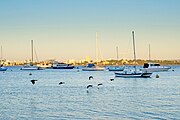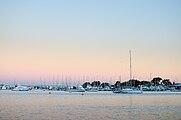Matilda Bay

Matilda Bay or Crawley Bay (known originally as Currie's Bay),[1] then Sutherland's Bay[2]) is a natural bay in the Swan River in Western Australia, adjacent to the Perth suburb of Crawley. It extends from Pelican Point to Mounts Bay Road below Kings Park.
The University of Western Australia is immediately opposite. Other landmarks on Matilda Bay include Matilda Bay Restaurant,[3] Pelican Point Sea Scouts, Royal Perth Yacht Club, UWA Rowing Club and Mounts Bay Sailing Club.
A well-known bronze sculpture that is located at the site of the former Crawley Baths – Eliza is displayed just offshore from Mounts Bay Road and depicts a woman preparing to dive.
Matilda Bay Reserve is a recreational parkland between Hackett Drive and the river. It includes Pelican Point, which is an important breeding sanctuary for migratory birds.
Matilda Bay is believed to have been named after the wife of John Septimus Roe, Matilda (née Bennett).[4]
History

Captain Currie was the first colonial owner of the 32-acre (130,000 m2) estate surrounding the bay, at that time known as Currie's Bay. Pelican Point was then known as Point Currie. The estate was sold in 1832 to the Assistant Surveyor and Colonial Treasurer, Henry Charles Sutherland for £100. Sutherland named the property Crawley Park after his mother's maiden name[5][6] and the bay became known as Sutherland's Bay. In 1876 Crawley Park was sold to Sir George Shenton, and the bay was known generally as Crawley Bay. After Shenton's death in 1909, the estate was acquired by the Government in 1910[7] and vested in the University of Western Australia in 1912.[8]
The US Navy had a fleet of Catalina flying boats based at Matilda Bay during World War II.[9]
In 1943, Qantas operated five Catalina flying boats between Ceylon (now Sri Lanka) and Matilda Bay in what was known as the Double Sunrise service.[10]
Image gallery
-
Ducks fly over the water at Matilda Bay during sunset
-
Sunset at Matilda Bay
See also
References
- ^ "To be let". The Perth Gazette and Western Australian Journal (WA. 8 August 1840. p. 1. Retrieved 20 November 2017.
- ^ "To be Sold or Let, on Easy Terms". The Perth Gazette and Independent Journal of Politics and News. 4 January 1861. p. 1. Retrieved 20 November 2017.
- ^ https://www.matildabayrestaurant.com.au
- ^ "By Stream and Surf". Western Mail. Perth: National Library of Australia. 25 November 1937. p. 15. Retrieved 13 January 2011.
- ^ "Shenton House". UWA. Retrieved 13 January 2011.
- ^ Brain, Alison V.(2001) Crawley Park and its occupants, 1829-1910. Early days, Vol.12, pt.1 (2001), p.39-46
- ^ "The Crawley Park Resumption". The West Australian. Perth, WA. 22 August 1910. p. 6. Retrieved 20 November 2017.
- ^ "The University Site". Western Mail. Perth, WA. 7 September 1912. p. 31. Retrieved 20 November 2017.
- ^ "The Catalina Base". The University of Western Australia, Archives and Records Management Services. Retrieved 25 August 2013.
- ^ "WORLD'S LONGEST AIR HOP TO BE "KANGAROO SERVICE"". The Argus. Melbourne: National Library of Australia. 7 August 1944. p. 2. Retrieved 29 December 2010.
External links
- Recent aerial photos by Richard Woldendorp [1]
- Earlier photographs of the Supermarina Southampton II flying boats by Reg Lambert [2] and Izzy Orloff of the same planes in 1928 [3]


